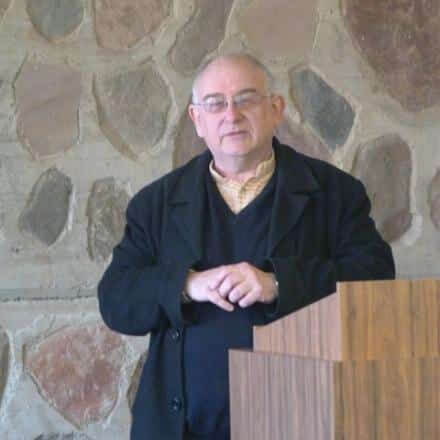 There are Hindi schools, kavi sammelans, Hindi radio stations and Hindi publications galore in Australia’s Indian community, all doing their bit to promote the cause of the language in this country.
There are Hindi schools, kavi sammelans, Hindi radio stations and Hindi publications galore in Australia’s Indian community, all doing their bit to promote the cause of the language in this country.
Yet, as Hindi-lover and academic Peter Friedlander observes, there is no coordinated effort for Hindi activities across Australia.
Dr Friedlander, Senior Lecturer in Hindi and Urdu at Australian National University’s College of Asia and the Pacific, recently organised a national conference to fill this gap. Held at ANU’s South Asian Research Institute, the day-long event in mid-July offered an opportunity for lovers of Hindi in Australia to meet and discuss the current state of Hindi nation-wide, in education, in the community, and in the media.
“The idea of the conference arose as I watched the developments going on around me as a teacher of Hindi,” Dr Friedlander told Indian Link. “There seemed to be plenty happening, but we didn’t have coordinated effort for Hindi across Australia – at least not as much we should or could have.”
When the Asian Century white paper was released in 2012, it proposed Hindi as a priority language, alongside Mandarin, Japanese and Indonesian, as part of the efforts to make Australia more Asia-literate. The Australian Curriculum, Assessment and Reporting Authority (ACARA) was charged with creating a national curriculum for Hindi language learning, to be put into action in 2016.
Hindi is being taught quite effectively already in some select schools.
“Melbourne’s Rangebank Primary School and Sydney’s West Ryde Public School for example have picked Hindi as a LOTE language across the board,” Dr Friedlander notes. “In Victoria, the Victorian School of Languages has been teaching Hindi since 1980.”

He adds, “On a community level as well, there is a lot happening, and I’m now discovering literary activities in places as far and wide as Wollongong and Woolgoolga and Perth. I thought it was important to have a conference which would for the first time assess what was going on and how the National Curriculum will impact these activities.”
The workshop attracted varied points of view. Listing the highlights, Dr Friedlander mentions ACARA’s Languages specialist Suzanne Bradshaw, who outlined the scope for Hindi in the National Curriculum, and Dinesh Srivastava (editor, Hindi Pushp), who provided an overview of Hindi in Australia since the 1980s, highlighting achievements and challenges.
“Representing the Indian government, Tarun Kumar, the Secretary for Community, Information & Culture was insightful too,” he adds. “Rekha Rajvanshi and Kumud Merani spoke about cultural activities in the community based on the Hindi language.”
Mala Mehta, the head of IABBV was very resourceful, using video technology to link with the conference from overseas, and showing how we can use it to teach Hindi as she did so successfully with the India Calling program a few years ago.
What draws Friedlander to India? He tells us of his love affair with the country, in his delightfully accented Hindi.
“Har taraf se Bharat ka aakarshan raha hai,” he reveals. “Bachpan se hi Hindustani logon se mulaakaat thi.”
Growing up in the UK, there were family friends of Indian origin, and an Austrian grandmother’s fascination for India saw many Indian artefacts like Ganesh statues around the house.
As he traveled in India in 1977, he realized, “Bharat ko underooni taraf se samajhne ke liye muje Hindi seekhni chahiye.”
As an amateur artist he sketched his way through Varanasi, and when people asked him what he was drawing, he wished he could speak their language.
“So I started teaching English in return for Hindi lessons. Aadaan pradaan ki baat thi!”
He was captivated by the people, culture and traditions of the land.
“Banaras apne aap mein Bharat ka namoona hai, as people from across the country travel there. Un dinon TV nahin tha, aur log kavita-shayari karte the. I loved my time there.”
He went back home to study Hindi and went on to teach it in the UK, in Singapore and in Australia at La Trobe University and then at ANU.
“ANU is the only Australian university that offers a major in the Hindi language today. It is an exciting centre of studies of India. We have as many as eight scholars working on India in different ways, in Urdu, and Sanskrit, and in history, anthropology and the like. Students kum hain, lekin jo hain won lagan se padhte hain, aur India se mantramugdh hain.”
As for now, Friedlander has his work cut out for him.
Three major motivations came out from the Canberra conference, he reveals.
“One, we hope to bring out a publication of all the different contributions to Hindi in Australia. Two, we’ve agreed to set up a website, a go-to point if you will, for Hindi in Australia. And three, we hope to meet on an annual basis to take stock of Hindi activities nation-wide, with Victoria possibly hosting next year.”
All we can say is, hamari shubhkamanayein aap ke saath hain.




